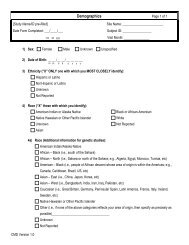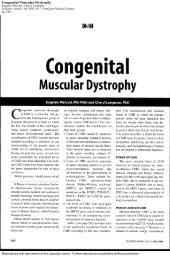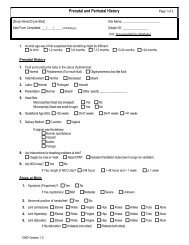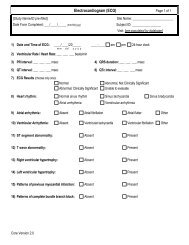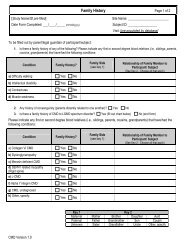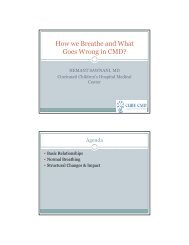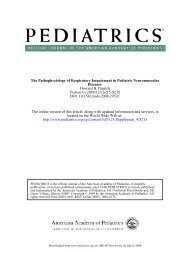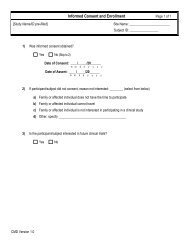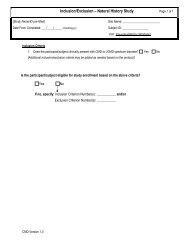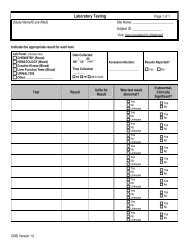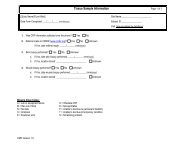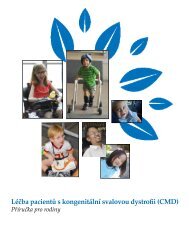The Management of Congenital Muscular Dystrophy ... - Cure CMD
The Management of Congenital Muscular Dystrophy ... - Cure CMD
The Management of Congenital Muscular Dystrophy ... - Cure CMD
You also want an ePaper? Increase the reach of your titles
YUMPU automatically turns print PDFs into web optimized ePapers that Google loves.
InterventionsSevere scoliosis can make it harder for the lungsto expand all the way and prevent a person fromtaking a “deep breath.” Your child may requirespinal bracing to slow the progression <strong>of</strong>scoliosis and maintain improved postureduring daily activities. When bracing is used itis important to consider its effect not only on thescoliosis, but also on the child’s breathing. Eachbrace needs to be evaluated to make sure it doesnot have a potentially negative effect onbreathing function. Your child’s orthopedistand pulmonologist should work together toensure that the brace is supportive enough forthe spine and doesn’t worsen breathing function.To assist with difficulties with effective breathing,your child’s clinician may recommend theuse <strong>of</strong> supportive breathing equipment(noninvasive or ventilator equipment), whichhas been shown to improve gas exchange,decrease chest infections, and decrease thefrequency and duration <strong>of</strong> hospital stays.Noninvasive ventilation is most commonlyrecommended when there is evidence <strong>of</strong>hypoventilation (weak breathing ability) or forany <strong>of</strong> the resulting signs and symptoms <strong>of</strong>respiration problems. Noninvasive ventilationtechniques are provided through a mask orother easily removable device.Bi-PAP (bilevel positive airway pressure) is acommonly used noninvasive ventilator usuallybegun for night-time support. It consists <strong>of</strong> asmall machine that pumps air through tubingconnected to an interface or mask that goes overyour child’s nose or mouth. Pressurized air thatsupports your child’s breath helps remove CO213when breathing out. A variety <strong>of</strong> interfaceoptions are available, based on your child’s age,skin condition, face shape, and ability to toleratethis intervention.Once your child begins to use noninvasive ventilation,he or she will need to undergo overnightmonitoring (sleep study), at least annually, toadjust ventilator settings and to check and adjustthe fit <strong>of</strong> the mask or other interface.Special care should be directed to the youngchild receiving long-term ventilation to helpaddress the potential complications <strong>of</strong> abnormalfacial development (midface hypoplasia). <strong>The</strong>use <strong>of</strong> individually fitted masks or alternatingbetween nasal pillows, nasal masks, and full facemasks may be helpful in preventing thiscomplication. Sip ventilation with a mouthpiecemay also be recommended for people whorequire breathing support during the day.Sometimes long-term mechanical ventilationmay need to be delivered via a surgically placedtube in the neck, called a tracheostomy tube.Indications for this include chronic aspirationwith repeated pneumonias or ineffectiveclearing <strong>of</strong> airway secretions despite the use <strong>of</strong>assistive interventions. Some people also prefera tracheostomy tube if they require noninvasiveventilation for the majority <strong>of</strong> the day and night.<strong>Management</strong> <strong>of</strong> AcuteRespiratory IllnessRespiratory tract infections (common cold andpneumonia) are the most frequent cause <strong>of</strong>hospital admissions and life-threateningsituations in individuals with <strong>CMD</strong>. When anacute respiratory infection is suspected, it isimportant to have your child evaluated, makingsure that you tell the clinician the type <strong>of</strong> <strong>CMD</strong>your child has and what you know about thedisease course.Signs <strong>of</strong> acute respiratory distress can besubtle but may include:• paleness• increased sleepiness• decreased appetite• unusual movement <strong>of</strong> chest and belly



